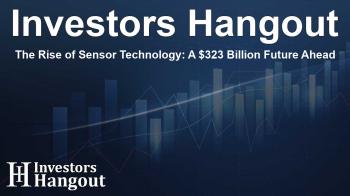The Rise of Sensor Technology: A $323 Billion Future Ahead

The Rise of Sensor Technology: A $323 Billion Future Ahead
Recently, a compelling study revealed that the global sensor technology market is set to explode, reaching an impressive $323.3 billion by 2030. This growth, fueled by a compound annual growth rate (CAGR) of 8.7% from previous years, highlights the integral role that sensors now play in our everyday lives.
Understanding the Market Dynamics
This insightful report dissects the expansive sensor market, which encompasses various types such as temperature, pressure, and image sensors. Sensors have become the heartbeat of both consumer and industrial technologies, transitioning from simple mechanical tools to sophisticated systems enhanced by artificial intelligence. The implications for industries ranging from automotive to smart home solutions are enormous, showcasing a diverse array of sensor applications.
Impact of Technology on Sensor Adoption
Among the key catalysts driving this growth is the IO-Link network technology. This smart communication protocol streamlines the connection between sensors, actuators, and control systems, promoting real-time data exchange that enhances industrial automation. Additionally, the introduction of MEMS sensors—compact, energy-efficient, and cost-effective—has revolutionized how devices monitor and respond to their environments.
The Role of Smart Devices
Home automation continues to gain traction as smart devices leverage sensor technology for enhanced user experience. These smart connected devices provide seamless control over lighting, security, and climate, leading to increased safety and energy efficiency. As the world gravitates toward IoT ecosystems, the demand for advanced sensors is bound to grow, reflecting a changing landscape in consumer electronics.
Transforming Urban and Industrial Landscapes
Sensors are gaining pivotal importance in smart city infrastructure and factory automation. In urban environments, sensors help manage traffic, energy consumption, and safety systems, surveilling vast networks of information to optimize operations. In manufacturing, automated systems enabled by sensor technology drive efficiency and sustainability, crucially supporting the transition to Industry 4.0.
Market Trends Fueling Growth
Several notable factors are propelling the sensor market's expansion:
- IO-Link Network Technology: Enhancing real-time data communication for improved operational efficiency.
- MEMS Sensors: Widely used in smartphones and wearables, these sensors significantly elevate the performance of mobile devices.
- Smart Connected and Home Automation Devices: The integration of sensors in these devices boosts both convenience and energy conservation.
- Smart City Infrastructure: An increasing reliance on data to manage urban frameworks effectively and sustainably.
Emerging Startups in Sensor Technology
The landscape of sensor technology is bustling with innovative startups:
- Core Sensing GmbH: The focus is on smart force and torque sensors that enhance machine component efficiency.
- Sensor Global: Tailoring solutions to meet diverse regional market needs.
- Contactile: Pioneering tactile sensors that facilitate advanced robotic handling and interaction in real-world applications.
Challenges and Market Potential
As the sensor market expands, challenges like inconsistent communication standards and competitive pricing must be addressed. Nonetheless, opportunities abound, particularly with the accelerating demand for miniaturization of sensors and advancements in hybrid and electric vehicle technologies. The automotive industry is notably anticipated to maintain dominance through the coming years.
Frequently Asked Questions
What is the projected market size and growth rate for sensor technology?
The sensor technology market is expected to hit $323.3 billion by 2030, with a remarkable CAGR of 8.7%.
What factors are contributing to the market's growth?
The growth is largely driven by innovations like IO-Link technology, the rise of MEMS sensors, and the demand for smart devices.
What are the main challenges faced by the sensor market?
The key challenges include a lack of standardized communication protocols and intense price competition among manufacturers.
Which sectors are primarily utilizando senor technology?
Prominent sectors such as automotive, industrial automation, and consumer electronics are leading the way in sensor utilization.
Which region is expected to dominate the sensor market?
The Americas, particularly the U.S., are projected to hold the largest market share due to innovation and early adoption of new technologies.
About The Author
Contact Henry Turner privately here. Or send an email with ATTN: Henry Turner as the subject to contact@investorshangout.com.
About Investors Hangout
Investors Hangout is a leading online stock forum for financial discussion and learning, offering a wide range of free tools and resources. It draws in traders of all levels, who exchange market knowledge, investigate trading tactics, and keep an eye on industry developments in real time. Featuring financial articles, stock message boards, quotes, charts, company profiles, and live news updates. Through cooperative learning and a wealth of informational resources, it helps users from novices creating their first portfolios to experts honing their techniques. Join Investors Hangout today: https://investorshangout.com/
The content of this article is based on factual, publicly available information and does not represent legal, financial, or investment advice. Investors Hangout does not offer financial advice, and the author is not a licensed financial advisor. Consult a qualified advisor before making any financial or investment decisions based on this article. This article should not be considered advice to purchase, sell, or hold any securities or other investments. If any of the material provided here is inaccurate, please contact us for corrections.

